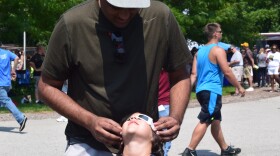Harmful algal blooms can impact local economies and the health of animals and humans. A University of Delaware researcher has invented a tool to help fight them.
Algae can grow out of control in bodies of water for a number of reasons, including an excess of nutrients.
The marine dinoflagellates Delaware Sea Grant Director Kathryn Coyne’s invention targets occur in local bays and estuaries. Their blooms can poison fish or make shellfish toxic for humans to eat.
“The dinoflagellates are among the most toxic harmful algal bloom species,” she said. “About 75 percent of harmful algal species are dinoflagellates— so they occur in this group that we’re targeting.”
Coyne says her team has identified a locally occurring species of bacteria in the Shewanella genus that can help fight dinoflagellate blooms.
“It can produce some kind of an algicidal compound,” she said. “These are compounds that the bacteria kind of secrete out into the water. And those compounds we’re finding will reduce the growth rate or even kill dinoflagellates.”
Coyne has studied the bacterial algicide for ten years. She calls it a “magic bullet,” because it appears not to harm other species in the ecosystem.
Her team has packaged the bacteria in gel-like beads. They can be put in mesh bags and deployed in areas at risk of toxic algal blooms— then removed.
“We have them embedded in these alginate beads. It’s kind of like a gelatin matrix,” she said. “It holds the bacteria in place. The algicidal compounds that are produced by the bacteria then are secreted out into the water.”
Coyne has a preliminary patent on the product, and will now move on to field testing it.








